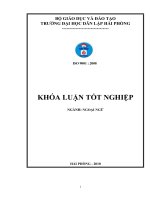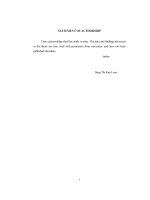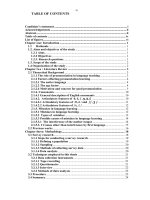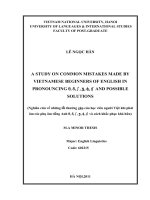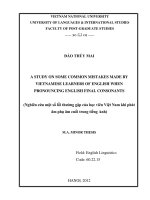A study on using some typical typers of punctuation properly in writen english and common mistake made by vietnamese learners
Bạn đang xem bản rút gọn của tài liệu. Xem và tải ngay bản đầy đủ của tài liệu tại đây (4.63 MB, 74 trang )
BỘ GIÁO DỤC VÀ ĐÀO TẠO
TRƯỜNG ĐẠI HỌC DÂN LẬP HẢI PHÒNG
-------------------------------
ISO 9001:2015
KHÓA LUẬN TỐT NGHIỆP
NGÀNH: NGÔN NGỮ ANH
Sinh viên: Trần Thùy Dương
Giảng viên hướng dẫn: ThS. Nguyễn Thị Quỳnh Hoa
HẢI PHÒNG - 2018
i
MINISTRY OF EDUCATION AND TRAINING
HAIPHONG PRIVATE UNIVERSITY
-----------------------------------
A STUDY ON USING SOME TYPICAL TYPERS OF
PUNCTUATION PROPERLY IN WRITEN ENGLISH
AND COMMON MISTAKE MADE BY VIETNAMESE
LEARNERS
GRADUATION PAPER
Student
Class
Supervisor
: Tran Thuy Duong
: NA1804
: Nguyen Thi Quynh Hoa (M.A)
HẢI PHÒNG – 2018
ii
BỘ GIÁO DỤC VÀ ĐÀO TẠO
TRƯỜNG ĐẠI HỌC DÂN LẬP HẢI PHÒNG
--------------------------------------
NHIỆM VỤ ĐỀ TÀI TỐT NGHIỆP
Sinh viên: Trần Thùy Dương
Mã SV:1412751116
Lớp: NA1804
Ngành:Ngôn Ngữ Anh
Tên đề tài: A study on using some typical typers of punctuation properly
in writen English and common mistake made by Vietnamese learners
iii
NHIỆM VỤ ĐỀ TÀI TỐT NGHIỆP
1. Nội dung và các yêu cầu cần giải quyết trong nhiệm vụ đề tài tốt nghiệp
( về lý luận, thực tiễn, các số liệu cần tính toán và các bản vẽ).
............................................................................
............................................................................
...........................................................................
...........................................................................
...........................................................................
...........................................................................
2. Các số liệu cần thiết để tính toán:
..........................................................................
..........................................................................
..........................................................................
..........................................................................
..........................................................................
CÁN BỘ HƯỚNG DẪN ĐỀ TÀI TỐT NGHIỆP
iv
Người hướng dẫn thứ nhất:
Họ và tên: Nguyễn Thị Quỳnh Hoa
Học hàm, học vị: Thạc sĩ
Cơ quan công tác: Trường Đại học Dân lập Hải Phòng
Nội dung hướng dẫn: A study on using some typical types of punctuation
properly in written English and common mistakes made by Vietnamese learners.
Người hướng dẫn thứ hai:
Họ và tên:.............................................................................................
Học hàm, học vị:...................................................................................
Cơ quan công tác:.................................................................................
Nội dung hướng dẫn:............................................................................
Đề tài tốt nghiệp được giao ngày tháng năm 2018
Yêu cầu phải hoàn thành xong trước ngày tháng 11 năm 2018
Đã nhận nhiệm vụ ĐTTN
Đã giao nhiệm vụ ĐTTN
Sinh viên
Người hướng dẫn
Hải Phòng, ngày
tháng
năm 2018
Hiệu trưởng
GS.TS.NGƯT Trần Hữu Nghị
v
PHẦN NHẬN XÉT CỦA CÁN BỘ HƯỚNG DẪN
1. Tinh thần thái độ của sinh viên trong quá trình làm đề tài tốt nghiệp:
……………………………………………………………………………..
……………………………………………………………………………..
……………………………………………………………………………..
……………………………………………………………………………..
……………………………………………………………………………..
2. Đánh giá chất lượng của khóa luận (so với nội dung yêu cầu đã đề ra
trong nhiệm vụ Đ.T. T.N trên các mặt lý luận, thực tiễn, tính toán số
liệu…):
……………………………………………………………………………..
……………………………………………………………………………..
……………………………………………………………………………..
……………………………………………………………………………..
……………………………………………………………………………..
3. Cho điểm của cán bộ hướng dẫn (ghi bằng cả số và chữ):
……………………………………………………………………………..
……………………………………………………………………………..
Hải Phòng, ngày … tháng … năm 2018
Cán bộ hướng dẫn
(Ký và ghi rõ họ tên)
vi
NHẬN XÉT ĐÁNH GIÁ
CỦA NGƯỜI CHẤM PHẢN BIỆN ĐỀ TÀI TỐT NGHIỆP
1. Đánh giá chất lượng đề tài tốt nghiệp về các mặt thu thập và phân tích
tài liệu, số liệu ban đầu, giá trị lí luận và thực tiễn của đề tài.
...............................................................................................................................
...............................................................................................................................
...............................................................................................................................
...............................................................................................................................
...............................................................................................................................
2. Cho điểm của người chấm phản biện : ………………………..
(Điểm ghi bằng số và chữ)
Ngày.......... tháng......... năm 2018
Người chấm phản biện
vii
ACKNOWLEDGEMENTS
In the process of completing this graduation paper, I have received a great
deal of help, guidance and encouragement from my teachers and friends.
First and foremost, I would like to express my sincere gratitude towards
my supervisor, Mrs.Nguyen Thi Quynh Hoa, M.A for helping me through this
challenging process.
Secondly, I also want to thank all teachers of Foreign Languages
Department of Hai Phong Private University for their supportive lectures during
my four-year study that have given me many wonderful insights as well as
background knowledge to help fulfill this study.
Last but not least, I would like to thank my family; my friends who have
offered continuous support, encouragement that help me complete this paper.
Hai Phong, November 2018
viii
TABLE OF CONTENTS
PART I: INTRODUCTION ................................................................................ 1
1. Rationale ......................................................................................................... 1
2. Aims of the study ............................................................................................ 1
3. Scope of the study ........................................................................................... 2
4. Methods of the study ....................................................................................... 2
5. Design of the study ......................................................................................... 2
PART II: DEVELOPMENT ............................................................................... 4
CHAPTER 1: THEORETICAL BACKGROUND ............................................. 4
I. GENERAL VIEW ON WRITTEN ENGLISH ................................................ 4
1. What is written English? ................................................................................. 4
2. Types of written English ................................................................................. 4
II. ENGLISH PUNCTUATION MARKS ........................................................... 5
1. What is punctuation? ....................................................................................... 5
2. Classification of punctuation. .......................................................................... 6
2.1. Grammatical points ...................................................................................... 6
2.1.1. The Comma [,] .......................................................................................... 6
2.1.2. The Semicolon [;] ...................................................................................... 7
2.1.3. The Colon [:] ............................................................................................. 7
2.1.4. The Period [.] ............................................................................................ 7
2.2. The Grammatical and Rhetorical points ....................................................... 7
2.2.2. The Exclamation mark [!] ......................................................................... 7
2.2.3. The Dash [---]............................................................................................ 8
2.2.3. The Parenthesis [()] ................................................................................... 8
2.3. Letter, syllabic and quotation points ............................................................ 8
2.3.1. The Apostrophe [’] .................................................................................... 8
2.3.2. The Hyphen [-] .......................................................................................... 9
2.3.3. The Quotation mark [“”], [‘’] .................................................................... 9
2.4. Miscellaneous points .................................................................................... 9
ix
2.4.2. A Comma Inverted [‘] ............................................................................. 10
2.4.3. Two Commas [,,]..................................................................................... 10
2.4.4. The Caret [^] ........................................................................................... 10
2.4.5. Marks of Ellipsis […] .............................................................................. 10
2.4.6. Slash [ /] .................................................................................................. 10
CHAPTER 2. AN INVESTIGATION ON SOME TYPICAL TYPES OF
PUNCTUATION IN WRITTEN ENGLISH. ................................................... 12
1. Comma. ......................................................................................................... 12
1.1 The Use of a Comma in the Words or Phrases that are joined by
coordinating conjunctions. ................................................................................ 12
1.2 The Use of Comma in Series of Words. ...................................................... 13
1.3. The Use of Comma with Words in Apposition (Nouns or Phrases in
Apposition). ...................................................................................................... 16
1.4. The Use of Comma in Relative Clauses. .................................................... 17
1.5 The Use of Comma in Adjectival, Participial, and Absolute Phrases.......... 18
1.6. The Use of Comma in Adverbs and Adverbial Phrases. ............................ 21
1.7. The Use of Comma in Dependent Clauses. ................................................ 23
1.8. The Use of Comma in Direct Quotations. .................................................. 24
1.9. Other Conventional Uses of Commas. ....................................................... 25
2. Semicolon. .................................................................................................... 27
2.1. The Use of Semicolon in Coordinate Clauses. ........................................... 27
2.2. The Use of Semicolon in a Series............................................................... 28
3. Colon ............................................................................................................. 28
3.1. The Use of Colon in Clauses. ..................................................................... 28
3.2. The Use of Colon in Quotations ................................................................. 29
3.3. The Use of Colon in Introducing a List or a Series. ................................... 29
3.4. The Other Conventional Uses of Colon. .................................................... 30
4. Periods .......................................................................................................... 31
4.1. The Use of Period in Sentences. ................................................................. 31
4.2. The Use of Period in Headings and Subheads. ........................................... 32
x
4.3. The Use of Periods in Abbreviations.......................................................... 33
5. Question Mark............................................................................................... 34
5.1. The Use of Question Mark in Indicating queries........................................ 34
5.2. The Use of Question Mark in Requests. ..................................................... 36
5.3. The Use of Question Marks in Rhetorical question. ................................... 36
5.4. The Use of Question Mark in Parenthesis to indicate uncertainty (?) ........ 37
5.5. The Uses of Question Mark with Other Puntuation Marks. ....................... 37
6.1.The Uses of Exclamation Marks in Strong Emotion or Emphatic
Declaration. ....................................................................................................... 38
6.2. The Use of Exclamation Mark in Rhetorical Questions. ............................ 40
6.3. The Use of Exclamation Mark For Drawing Attention to unlikely points.. 41
CHAPTER 3: THE IMPLICATION OF THE STUDY .................................... 42
3.Data analysis. ................................................................................................. 42
3.1. Students’ years of studying English ........................................................... 42
3.2. Feeling of students about studying English. ............................................... 43
3.3. Students feedback about the most difficult skills. ...................................... 43
3.5. Students common mistakes in writing skills. ............................................. 44
3.6. Students’ common mistakes. ...................................................................... 44
3.7. Students’ frequency of making mistakes. ................................................... 45
PART III. CONCLUSION ................................................................................ 46
1.Suggested solutions for some common punctuation mistakes. ....................... 46
1.1. Comma Splice. ........................................................................................... 46
1.3. Colon after such as, including, to be. ......................................................... 47
2. Conclusion .................................................................................................... 47
REFERENCES ................................................................................................. 48
APPENDICES IN SURVEY QUESTIONNAIRE ............................................ 49
3. Students’ mistakes collected from their writings........................................... 61
3.1. Students’ understanding of comma and comma errors. .............................. 61
3.2 Students’ undestanding of colon and colon errors. ...................................... 62
3.3.Students’ undestanding of period and period errors. ................................... 62
xi
TABLE OF FIGURE
Figure 1: Students’ years of studying English ................................................... 42
Figure 2: Feeling of students about studying English ....................................... 43
Figure 3: Students feedback about the most difficult skills. .............................. 43
Figure 4: Students’ English favorite skill. .......................................................... 44
Figure 5: Students common mistakes in writing skills. ...................................... 44
Figure 6: Students’ common mistakes. .............................................................. 44
xii
PART I: INTRODUCTION
1. Rationale
During four years studying at the university, I have realized that writing
is a difficult skill, which requires a basic background of English grammar. In
written English, writers always have to pay attention to many grammar factors
such as tenses, sentence structures, parts of speech, conjunctions, and
punctuation marks. Each of them plays a vital role in making a correct sentence,
especially punctuation. A complete sentence hardly ever misses punctuation
marks. Each of them plays an important part in making a correct sentence,
especially punctuations. A complete sentence hardly ever misses punctuation
marks. In fact, punctuation marks have a big role in making clear the meaning
of a sentence, avoiding the ambiguity.
Despite having learned it from the university, I am still aware of that I
need to study much more about punctuation and their rules because of some
reasons. Firstly, I also have made many mistakes on punctuation when I write.
Moreover, I want to find out the reasons and solution for those mistakes.
Secondly, understanding well the usage of some typical punctuation such as
period, comma, colon, semicolon, question mark, and exclamation mark is
necessary for my life.
For the reasons mentioned above, I have decided to choose the title “How
to use some typical types of punctuation properly in written English and
common mistakes made by Vietnamese learners” for my study.
2. Aims of the study
The fact is, we all write in such these days, and punctuation is one of the
first casualties. Difficulties with punctuation affect all writers, whether they are
native speakers or otherwise. Therefore, I particularly want to take clear the rule
of using punctuation in my study with there following aims:
- Giving a general view on written English and punctuation with its
definition, classification, function, role.
1
- Providing the basic rules of some typical types of punctuation such as
period (or full stop), commas, colon, semicolon, question mark, and
exclamation mark.
- Indicating some common mistakes made by Vietnamese learners, giving
solution for them.
3. Scope of the study
Punctuation marks in written English are rather various. However, the
research on all kinds of punctuation in written English is too hard for an
undergraduate student like me. Therefore, in this paper, I just focus on studying
the rules of using some typical types of punctuation that are often used most in
writing such as comma, colon, semicolon, period (or full stop), question mark
(or interrogation mark), and exclamation mark.
4. Methods of the study
Quantitative method: During my research process, I chose the
quantitative method to analyze my data that I collected through the survey
questionnaires on the common punctuation mistakes make by Vietnamese
learners. I also use some charts to express the figures and analyze them.
Other methods:
- Acquiring and referring to the guidance from my teachers.
- Getting all necessary information from internet, books, dictionaries, and
library.
5. Design of the study
This paper provides a clear organization consisting three main parts that
help an easy exploration and practical benefits gained for readers as well.
PART I starts with an INTRODUCTION including Rationale, Aims of
the study, Scope of the study, and Method of the study and Design of the study.
PART II consists of DEVELOPMENT consisting three chapters as
following:
2
Chapter 1: Theoretical background of written English, punctuation with
its definition, classification, functions, and role.
Chapter 2: An investigation on some typical types of punctuation in
written English.
Chapter 3: The implication of the body.
PART III ends with CONCLUSION, which summarizes the knowledge
mentioned through three chapters above.
3
PART II: DEVELOPMENT
CHAPTER 1: THEORETICAL BACKGROUND
I. GENERAL VIEW ON WRITTEN ENGLISH
1. What is written English?
Written English is a way of recording English language using any of
various instruments and material, such as pen and paper, chisel and stone, or
computers. The language itself is either spoken or signed, so written language
develops as a way of representing what has been said. In many cultures,
community languages are unwritten.
There are several writing systems in use around the word, which record
different elements of the languages they record. A syllabary, for example,
assigns a symbol to each significant syllable of the language, while an alphabet
records individual phonemes. Other systems involve symbols that usually
incorporate meaning, such as Chinese characters. The decision over which
system to use can be purely political or historical in nature, or there can be
arguments that one system is better suited to the nature of a particular language.
In fact, written English has many differences from spoken language. One
of the most essential differences between them is the degree of formality. In
general, we often our writing is often more formal than our speaking. Because,
in spoken English, we can see listeners and may know well about them, our
speaking can be less formal. Nevertheless, in written English, writer does not
know readers personally. Therefore, they have to use words and sentences
formally and clearly in order to serve a variety of readers.
2. Types of written English
In written English, types of texts are very various depending on the using
purposes of writers. According to Writing of Hedge, T. 1988. Oxford University
Press, written English has some types as follow:
Personal writing: Diaries, Journals, Shopping Lists, packing Lists,
Addresses, Recipes.
4
Public writing: Letters of enquiry, complain, request, Form filling,
Applications (for membership).
Creative
writing:
Poems,
Stories,
Rhymes,
Drama,
Songs,
Autobiography.
Social writing: Letters, Invitations, Notes, Cablegrams, Telephone
messages, Instructions to friends or friends.
Study writing: Making notes while reading, talking notes from lecturer,
making a card index, SUMMARIES, Synopses, Reviews, Reports, Essays,
Bibliographies.
Institutional
Contracts,
writing:
Agendas,
Minutes,
Memoranda,
Reports,
Business letters, Public notices, Advertisements, Speeches,
Curriculum Vitae, Specifications, Note-making.
All the types of written English mentioned above are commonly used in
life. Some of them such as social writing, study writing, and institutional
writing are required to be strict in English grammar and punctuation. If one of
above texts has poor punctuation and grammar, it cannot convey a writer’s
senses to his readers. Therefore, knowing how to use punctuation and grammar
properly in written English is extremely important to language learners.
II. ENGLISH PUNCTUATION MARKS
1. What is punctuation?
Punctuation is the practice or system of using conventional marks or
characters to make clear the meaning of written or printed language.
Punctuation marks are used to add emphasis, minimize ambiguity, and aid
reader comprehension.
In Principle of English punctuation (1898), George Smallfield stated that:
“Punctuation is the art of diving a written or printed composition into sentences,
or into parts of sentences, by the use of points, or stops, for the purpose of
making the different pauses which the sense and an accurate pronunciation
require”.
5
We also have another definition of punctuation: “In every language,
besides the sounds of the words that are strung together, there are other features
such as tone, accent, and pauses that are equally
significant. Such features are represented by punctuation, indicated by
signs inserted usually between words, and often following the feature they
mark”.
Because of the popularity of punctuation, each writer or dictionary has its
own definitions of punctuation. In my opinion, punctuation is set of symbols
used in writing to help indicate something about the structure of sentences, or to
assist readers in understanding the whole meaning of texts given by writers.
2. Classification of punctuation.
Punctuation marks in written English can be classified into four main
groups: Grammatical points, Grammatical and Rhetorical points, Letter,
syllabic and quotation points, Miscellaneous points.
2.1. Grammatical points
In this part, I would like to devote the consideration of the principal
sentential marks including comma, semicolon, colon and period.
2.1.1. The Comma [,]
The comma is used for a wide range of different purposes in punctuation.
A comma may be used to separate units of a sentence such as an introduction or
parenthetical thought, to separate items in lists such a this one, to lead a
sentence into a quotation, and to separate independent clauses joined by a word
such as “and” or “yet”. Comma also has a large number of uses, which will be
shown in details in the Chapter 2.
Here is an example of using comma in sentences:
He is a greedy, stubborn, and selfish child.
6
2.1.2. The Semicolon [;]
Semicolons, like all punctuation marks, ensure clarity in written language
by joining independent clauses and separating items in a list. Let’s see an
example of semicolon:
She lives in a small cottage in Roma, miles from the nearest town; the
cottage is without gas, running water or electricity.
2.1.3. The Colon [:]
We often see a colon to appear in lists, or quotation marks. A colon is a
unit of punctuation typically used to introduce a subsequent sentence that is in
some way logically linked to the preceding sentence.
Example:
1. Success depends on three things: talent, determination, and luck.
2. Dear Mr. Mayor:
(John E. Lincoln, Writing a college handbook, 433)
2.1.4. The Period [.]
A period is the default terminal punctuation mark, used to end a sentence
without conveying any additional meaning. Its primary purpose is to separate
complete thoughts, to mark the end of declarative and imperative sentences.
Example:
She is a beautiful and talent singer.
2.2. The Grammatical and Rhetorical points
A part from the above punctuation marks, there are some other marks,
partly grammatical and partly rhetorical including the Question or Interrogation
nark, the Exclamation mark, the Dash, and the Parenthesis.
2.2.2. The Exclamation mark [!]
An exclamation mark indicates that the preceding sentence is somehow
excited or extremely important, and if read aloud should be given special stress.
There are some examples of exclamation mark as follows:
What a beautiful girl it is!
7
2.2.3. The Dash [---]
Dashes are used for many different purposes, often to link special things
together. Dashes include three types: figure dash, end dash, and em dash. A
figure dash is used to link numbers together such as in a phone number. An end
dash is used to link things that are within a closed range of values, such as those
between dates, times, or page numbers. An em dash is traditionally used to
separate a thought from the flow of the sentence – like this – in an almost
parenthetical manner.
En dash: June-July 1967 1:00 – 2:00 p.m. For ages 3-5
Page: 38-55
Em dash: “The whole group had attended --- even Matt and
Rebecca --- and I knew it was going to be a great night”
2.2.3. The Parenthesis [()]
A parenthesis consists of two curved lines (), which is a clause containing
some necessary information, or useful remarks introducing the body of a
sentence indirectly, but can be omitted without affecting the sense or the
construction of the whole sentence, for example:
Ex: only a few weeks late, the company announced its intention to
purchase the consumer products division (flour and pasta) of one of its smaller
competitors.
2.3. Letter, syllabic and quotation points
The marks being considered in this chapter are the Apostrophe, the
Hyphen, and the Quotation marks.
2.3.1. The Apostrophe [’]
Apostrophe is a mark, which is distinguished from a comma, only being
placed above the line; but its uses are very different. This mark of elision or
shortening is used chiefly in poetry and in familiar dialogue, to denote the
omission of a letter or words.
8
For example:
I have
I’ve
Over
o’er
Them
’em
Do not
don’t
The genitive case of nouns, in both the singular and the plural, is also
marked by an apostrophe.
2.3.2. The Hyphen [-]
Hyphens are punctuation marks, which look similar to dashes, but are
shorter, and are used to join compound words, which have not yet become
independent words.
The hyphen is sometimes used to join the constituent parts of compound
and derivative words. Here are some examples of hyphen:
Can you spell your name?
- Yes, M-A-R-C-T-H-O-N-Y
The vice-chairman has just resigned for six months.
2.3.3. The Quotation mark [“”], [‘’]
Quotation marks are used to show that the words of an author or a
speaker are quoted. There marks consist of two inverted commas placed at the
beginning, and two apostrophes at the end. The most common type of quotation
marks is double quotes [“”]. Single quotation marks [‘’], which are a type of
punctuation that look similar to an apostrophe, may be used for quotations
within quotations. For example:
“There is much to like about that.” She said.
2.4. Miscellaneous points
In addition to the sentential points and marks spoken in the preceding parts,
there are other points, which sometimes occur in written English and will be
explained in the following parts.
2.4.1. The Brackets []
The brackets are used for the same purpose nearly as the marks of
parenthesis; but they are usually confined to works, phrases, or sentences,
inserted in or appended to a quotation, and not belong to it. For example:
9
“The captain had several men died [who died] in the ship.”
(John Wilson, 1868:236)
2.4.2. A Comma Inverted [‘]
According to John Wilson, a comma inverted is sometimes used instead
of a very small c, in many proper names beginning with Mac; as, McDonald,
the abbreviation of Macdonald.
2.4.3. Two Commas [,,]
There marks are occasionally employed to indicate that something is
understood which was expressed in the line and work immediately above, for
example:
John Jones, Esq………………………………… Plymouth
John Smith, Esq…………………………………….
(John Wilson, 1868:237)
2.4.4. The Caret [^]
John Wilson also started that the caret is used, only in manuscript, to
show where a letter or a word was accidentally omitted, but which has
afterwards been placed over the line; as,
p
are
Disappointments and trial often blessing in disguise.
^
^
2.4.5. Marks of Ellipsis […]
Marks or points of ellipsis are used in formal writing to indicate an
omission from quoted matter, for example:
This combination caused Wright to wonder whether “since the
interference velocities due to … walls are opposite signs…, opposite effects
might be so combined in a slotted tunnel as to produce zero blockage.”
2.4.6. Slash [ /]
A slash, also called solidus or virgule, can be correctly used in and/or, in
fraction (x/y), to indicate per (m/sec), and when quoting poetry.
10
3. Main functions of Punctuation Marks
Punctuation is the system of signs or symbols given to a reader to show
how a sentence is constructed and how it should be read.
Sentences are the building blocks used to construct written accounts.
They are complete statements. Punctuation shows how the sentence should be
read and makes the meaning clear.
Every sentence should include at least a capital letter at the start, and a
full stop, exclamation mark or question mark at the end. This basic system
indicates that the sentence is complete.
11
CHAPTER 2. AN INVESTIGATION ON SOME TYPICAL TYPES OF
PUNCTUATION IN WRITTEN ENGLISH.
I. WHAT IS TYPICAL TYPES OF PUNCTUATION MARKS IN WRITTEN
ENGLISH?
1. Comma
2. Semicolon
3. Colon
4. Period
5. Question Mark
6. Exclamation Mark
II. RULES OF USING SOME TYPICAL TYPES OF PUNCTUATION
MARKS
1. Comma.
1.1 The Use of a Comma in the Words or Phrases that are joined by
coordinating conjunctions.
Conjunctions are words or phrases that are used to join two independent clauses
together.
Coordinating conjunctions are and/or/but/nor/ as/for/so. When they are used to
connect two independent clauses together they should be accompanied by a
comma, which comes before the coordinating conjunction.
AND of all the coordinating conjunctions, ‘and’ is the most common and the
one where the use or otherwise of the comma is possibly most troublesome. The
comma is needed if the ‘and’ is used to connect two independent clauses.
Paul went to Kenya for his holiday, and Steve went to Dorset.
If, however, it is used simply to connect two elements in the same or sentence,
no comma is required.
Paul and Steve went to sunny Barrow in Furness on holiday this year.
12
BUT requires a comma when acting as a coordinating conjunction, connecting
two independent clauses.
The weather was fine on Sunday, but we chose to stay in and watch TV.
When used to connect two ideas with the idea of ‘with the exception of’, no
comma is needed.
Everybody but Jim got a new pencil.
OR Again, a comma is required when or is used to separate two independent
clauses.
I can cook something special tonight, or Jim can zoom down to the fish and chip
shop.
If it is used to separate two elements in the same sentence, no comma is needed.
You can have fish or chicken.
1.2 The Use of Comma in Series of Words.
Rule 1: Use commas to separate words and word groups in a simple series of
three or more items.
Example: My estate goes to my husband, san, daughter-in-law, and nephew.
Rule 2: Use a comma to separate two adjectives when the order of the
adjectives is interchangeable.
Example: He is a strong, healthy man.
Rule 3a: Many inexperienced writers run two independent clauses together by
using a comma instead of a period. This results in the dreaded run-on sentence
or, more technically, a comma splice.
Incorrect: He walked all the way home, he shut the door.
Correct: He walked all the way home. He shut the door.
Rule 3b: In sentences where two independent clauses are joined by connectors
such as and, or, but, etc…, put a comma at the end of the first clause.
Incorrect: He walked all the way home and shut the door.
Correct: He walked all the way home, and he shut the door.
13


